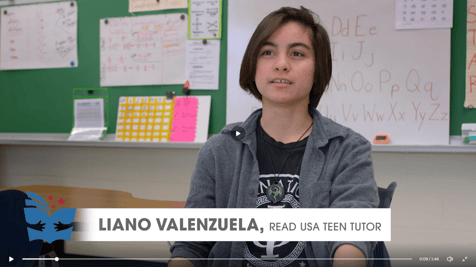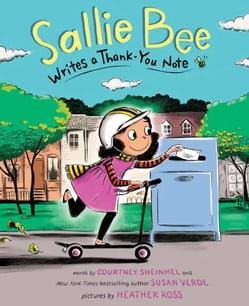Perspective: READ USA Teen Tutor Discusses Impact of Literacy Tutoring
Our teenage tutors are the backbone of READ USA’s Literacy Tutoring program, and we at READ USA could not be prouder or more in awe of their hard work and personal dedication to helping our elementary students succeed!
Hear directly from Liano Valenzuela, one of our many exceptional teen tutors, about what tutoring means to him and the elementary students he tutors:

Read more about our Literacy Tutoring program here and you can make a donation to support this program here.
Children’s Book: Sallie Bee Writes a Thank-You Note, by Susan Verde and Courtney Sheinmel

Illustrated by Heather Ross
Sallie receives a handmade scarf from her grandmother and learns to write her very first thank-you note! She loves showing thanks so much that she begins thanking everyone in town for the things she is thankful for. She sees opportunities for thankfulness with the crossing guard, the lunch lady, and really anyone that does something good for her. In addition to highlighting the need for thankfulness, fitting for November, kids learn tips on how to write a great thank-you note. Sure to teach important lessons about kindness and community, the hope is that even us grown-ups can be inspired to write thank-you notes to those who show us a little bit of kindness.
Submitted by Tabetha Cox, Tutoring Program Director
Education Corner -The Five Pillars of Reading
For the next five weeks we will be focusing on the five components of reading and looking at ways to help students grow in each of these areas. This week our focus will be on playfully building phonological awareness in pre and emergent readers.
- Phonological awareness – awareness of the sound structure of words
- Phonics – correlating sounds with letters or groups of letters
- Fluency – accuracy, rate and expression while reading
- Vocabulary – the body of words a child has learned
- Reading comprehension – the understanding and interpretation of what is read
Phonological Awareness, or the awareness of sounds in a language, is a multi-layered component of reading. Scientists have studied the brains of those who are not strong readers and found that instead of having a well-developed phonological assembly region on the left side of the brain, they're doing a lot of their reading work on the right side of the brain, which is not efficient. Below are some ways parents can help young readers begin to polish those phonological awareness skills.
- Play the traditional game of “Simon Says.” Children must listen carefully for the words “Simon Says” and to the directions “Simon” provides. Begin with one direction, then increase the number of directions over time, with two, three, and four directions.
- Sing songs, such as “The Hokey Pokey” that require children to follow instructions. Model the motions then later sing it without modeling, so children rely on listening rather than watching.
- Share the rhyme, “To Market! To Market!” with children. After children know the rhyme well, emphasize the rhyming words. Point out that the author changed jiggety jig to jiggety jog to create a rhyme for log. Change one of the words and ask children to try to complete the rhyme. For example, rather than sayi8ng, “To market, to market, to buy some whole milk.” Say the new version and pause after the words, “Home again, home again, jiggety…” in the second line. Have children complete the phrase. As children what else they might find at a market and create a rhyme together.
“To Market! To Market!”
To market, to market, to buy a fat pig,
Home again, home again, jiggety jig;
To market, to market, to buy a fat hog,
Home again, home again, jiggety jog;
To market, to market, to buy a plum bun,
Home again, home again, market is done.
Phonological awareness is a crucial foundation of literacy. Practice should be playful and positive, so read, sing, and play games with words together as you make those summer memories!
Access more resources for phonological awareness here.